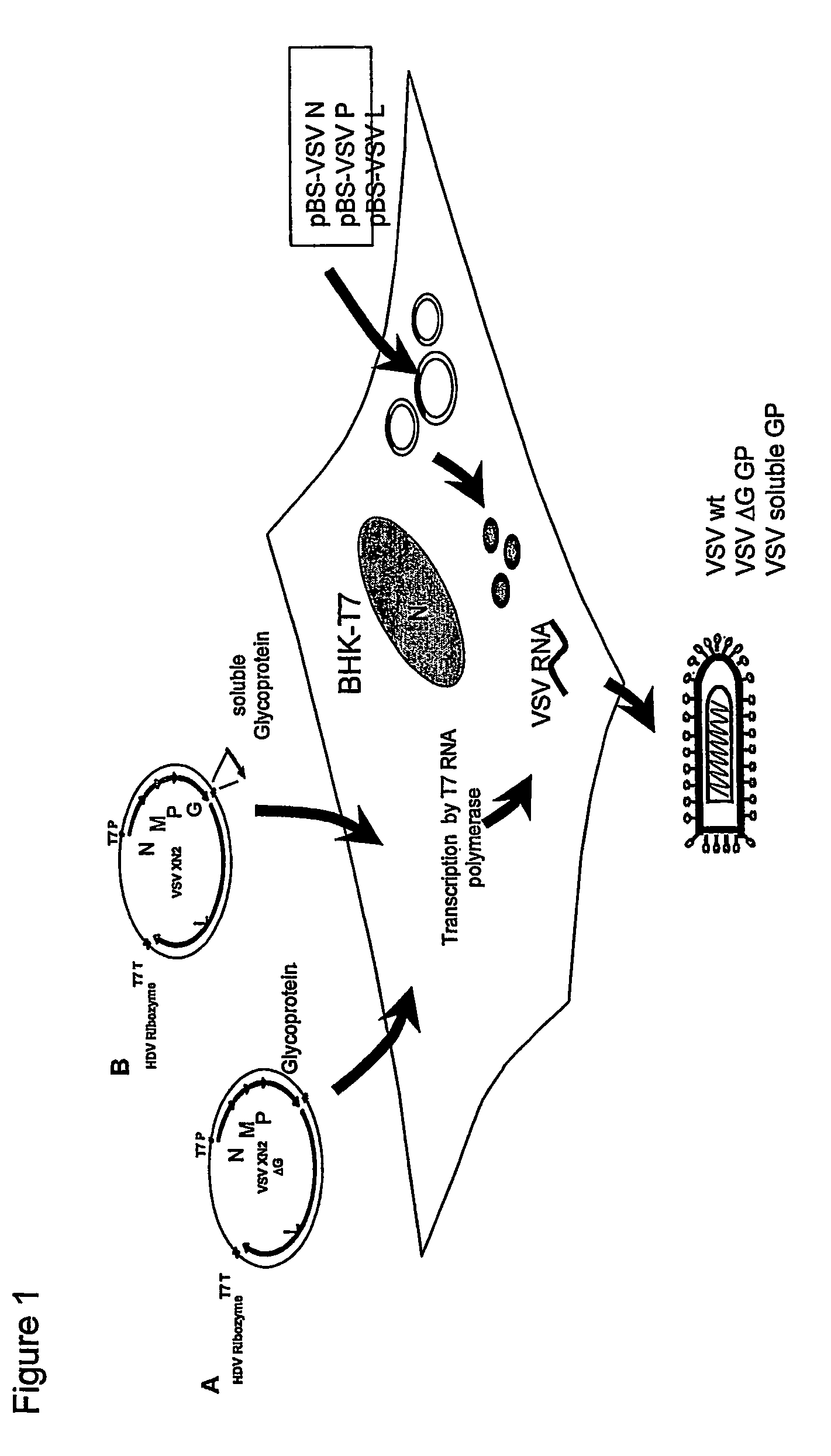Recombinant vesicular stomatitis virus vaccines for viral hemorrhagic fevers
a technology of vesicular stomatitis virus and vaccine, which is applied in the field of recombinant viruses and protective immune responses, can solve the problems of high biological containment needed for their manipulation, impeded virus studies, and low titre, and the virus propagation is usually slow and low
- Summary
- Abstract
- Description
- Claims
- Application Information
AI Technical Summary
Problems solved by technology
Method used
Image
Examples
example i
Plasmid Construction
[0039]A plasmid expressing the positive-strand RNA complement of the VSV genome with a site for foreign gene expression was described previously (Schnell, 1996). This plasmid contains the five VSV genes (nucleoprotein N, phosphoprotein P, matrixprotein M, glycoprotein G, and polymerase L) in order flanked by the bacteriophage T7 promoter, the VSV leader, the hepatitis delta virus (HDV) ribozyme, and the T7 terminator sequence. Between the G- and the L-gene a unique linker site (XhoI, NheI) is present, flanked by a transcriptional start and stop signal for the additional gene to be expressed. The genes encoding the soluble glycoproteins of Ebola virus (sGP) and Marburg virus (GP1) genes were cloned into the XhoI and NheI sites of the full length VSVXN2 vector (Schnell et al, 1996). The plasmids obtained were designated pVSVxn2 / mbgGP1 and pVSVxn2 / ebosGP respectively and have the foreign genes located between the VSV-G and L genes. The open reading frames encoding t...
example ii
Transfection and Rescue of Recombinant VSV (Recovery of Recombinant VSV
[0040]Recombinant VSVs were recovered using established methods. Baby hamster kidney cells constitutively expressing the bacteriophage T7 polymerase (BHK-T7) were grown to approximately 90% confluency in 6 cm dishes. The cells were then transfected in BSL2 with the support plasmids encoding the viral ribonucleoprotein (RNP) constituents, 0.5 μg PBS-N, 1.25 μg PBS-P, 0.25 μg PBS-L, and 2 μg of the plasmid encoding one of the above-described five recombinant genomic clones. Transfections were performed with Lipofectamine 2000 (Invitrogen), according to manufacturer's instructions. Since biosafety classification of these recombinant viruses had not been done at this time, we transferred the transfected cells immediately into BSL4. After 48 h at 37° C., supernatants were blind passaged onto VeroE6 cells (80-90% confluent). Subsequently, the recombinant VSV viruses have been classified as Biological containment level ...
example iii
Immunfluorescence Microscopy
[0041]VeroE6 cells grown on coverslips were infected with the recombinant VSV at an MOI of 1. Following virus adsorption for 45 minutes at 37° C., the inoculum was replaced by Dulbeccos modified essential medium (DMEM) containing 2% FCS. Cells were fixed 24 hours post infection with 4% paraformaldehyde in PBS overnight. After a change of paraformaldehyde, cells were removed from BSL4 and gamma-irradiated (2×106 rad). After inactivation, cells were washed with PBS and permeabilized with 0.1% triton-×100 in PBS for 15 minutes. Subsequently, the cells were incubated for 1 hour at room temperature with an appropriate primary antibody (diluted in PBS). The samples were washed three times with PBS and incubated for another hour with either a Cy3- or FITC-conjugated secondary (anti-species) antibody. Following washing (3 times), coverslips were mounted with Supermount (Biogenex, Germany) and examined with a Zeiss microscope.
PUM
| Property | Measurement | Unit |
|---|---|---|
| phase contrast microscopy | aaaaa | aaaaa |
| percentage weight change | aaaaa | aaaaa |
| body weight | aaaaa | aaaaa |
Abstract
Description
Claims
Application Information
 Login to View More
Login to View More - R&D
- Intellectual Property
- Life Sciences
- Materials
- Tech Scout
- Unparalleled Data Quality
- Higher Quality Content
- 60% Fewer Hallucinations
Browse by: Latest US Patents, China's latest patents, Technical Efficacy Thesaurus, Application Domain, Technology Topic, Popular Technical Reports.
© 2025 PatSnap. All rights reserved.Legal|Privacy policy|Modern Slavery Act Transparency Statement|Sitemap|About US| Contact US: help@patsnap.com



